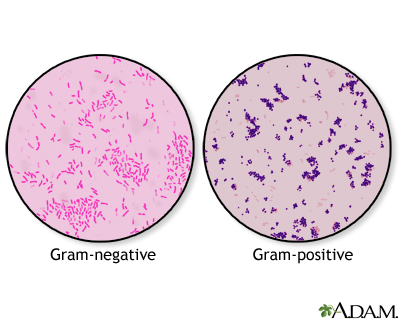CSF smear
Spinal fluid smear; Cerebrospinal fluid smear
A cerebrospinal fluid (CSF) smear is a laboratory test to look for bacteria, fungi, and viruses in the fluid that moves in the space around the spinal cord and brain. CSF protects the brain and spinal cord from injury.

Cerebral spinal fluid (CSF) is a clear fluid that circulates in the space surrounding the spinal cord and brain. CSF protects the brain and spinal cord from injury by acting like a liquid cushion. CSF is usually obtained through a lumbar puncture (spinal tap). During the procedure, a needle is inserted usually between the 3rd and 4th lumbar vertebrae and the CSF fluid is collected for testing.

A Gram stain is a test used to help identify bacteria. The tested sample can be taken from body fluids that do not normally contain bacteria, such as blood, urine, or cerebrospinal fluid. A sample can also be taken from the site of a suspected infection, such as the throat, lungs, genitals, or skin. Bacteria are classified as either Gram-positive or Gram-negative, based on how they color in reaction with the Gram stain. The Gram stain is colored purple. When combined with the bacteria in a sample, the stain will either stay purple inside the bacteria (Gram-positive), or it will turn pink (Gram-negative). Examples of Gram-positive bacteria include Streptococcus and Staphylococcus aureus, as well as bacteria that cause anthrax, diphtheria, and toxic shock syndrome. Examples of Gram-negative bacteria include Escherichia coli (E coli), Salmonella, Hemophilus influenzae, as well as many bacteria that cause urinary tract infections, pneumonia, or peritonitis.
How the Test is Performed
A sample of CSF is needed. This is usually done with a lumbar puncture (also called a spinal tap).
The sample is sent to a laboratory. There, a tiny amount is spread on a glass slide. Laboratory staff then views the sample under a microscope. The smear shows the color of the fluid and the number and shape of cells present in the fluid. Other tests may be done to check for the presence of bacteria or fungi in the sample.
How to Prepare for the Test
Follow instructions on how to prepare for a spinal tap.
Why the Test is Performed
Your health care provider may order this test if you have signs of an infection that affects the brain or nervous system. The test helps identify what is causing the infection. This will help your provider decide on the best treatment.
Normal Results
A normal test result means there are no signs of an infection. This is also called a negative result. However, a normal result doesn't mean that there is no infection. The spinal tap and CSF smear may need to be done again or other tests may be needed.
What Abnormal Results Mean
Bacteria or other germs found in the sample may be a sign of meningitis. This is an infection of the membranes covering the brain and spinal cord. The infection can be caused by bacteria, fungi, or viruses.
Risks
A laboratory smear poses no risk. Your provider will tell you about the risks of a spinal tap.
References
Karcher DS, McPherson RA. Cerebrospinal, synovial, serous body fluids, and alternative specimens. In: McPherson RA, Pincus MR, eds. Henry's Clinical Diagnosis and Management by Laboratory Methods. 24th ed. Philadelphia, PA: Elsevier; 2022:chap 30.
O'Connell TX. Cerebrospinal fluid evaluation. In: O'Connell TX, ed. Instant Work-Ups: A Clinical Guide to Medicine. 2nd ed. Philadelphia, PA: Elsevier; 2017:chap 9.
Version Info
Last reviewed on: 9/10/2022
Reviewed by: Jatin M. Vyas, MD, PhD, Associate Professor in Medicine, Harvard Medical School; Associate in Medicine, Division of Infectious Disease, Department of Medicine, Massachusetts General Hospital, Boston, MA. Also reviewed by David C. Dugdale, MD, Medical Director, Brenda Conaway, Editorial Director, and the A.D.A.M. Editorial team.
